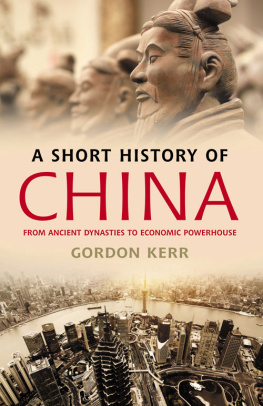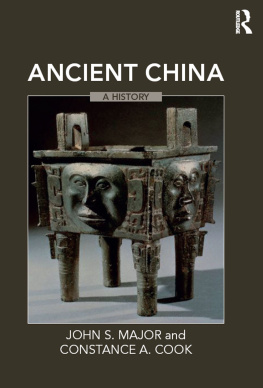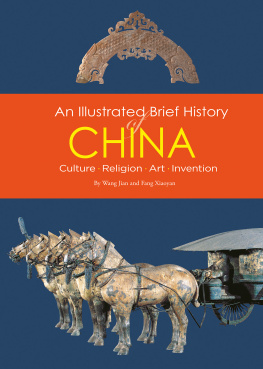Bibliography
Atwell, Pamela, British Mandarins and Chinese Reformers , Hong Kong: Oxford University Press, 1985.
Auden, W. H. and Isherwood, Christopher, Journey to a War, London: Faber & Faber, 1973.
Bland, J. O., and Backhouse, E., China Under the Empress Dowager , London: William Heinemann, 1910.
Bonavia, David, China's Warlords, Hong Kong: Oxford University Press, 1995.
Bonavia, Judy, The Yangzi River, Hong Kong: Odyssey, 1995.
Boxer, C. R., Fidalgos in the Far East, London: Oxford University Press, 1968.
Chan, Charis, Imperial China, London: Penguin Books, 1992.
Chang, Iris, The Rape of Nanking, London: Penguin Books, 1997.
Coates, Austin, China Races , Hong Kong: Oxford University Press, 1983.
Collis, Maurice, Foreign Mud, London: Faber & Faber, 1956.
Collis, Maurice, The Great Within, London: Faber & Faber, 1941.
Crow, Carl, 400 Million Customers, London: Hamish Hamilton, 1937.
Cunningham, Alfred, The Chinese Soldier , Hong Kong: Daily Press, 1899.
Denby, Jay, Tetters from China , London: Murray & Evenden, 1911.
Drage, Charles, General of Fortune, London: Heinemann, 1963.
Drage, Charles, Two-Gun Cohen, London: Johnathan Cape, 1954.
Flemming, Peter, One's Company, London: Jonathan Cape, 1934.
Flemming, Peter, The Siege at Peking, Oxford: Oxford University Press, 1984.
Grant, Sir Hope, Incidents of the China War of I860, London: William Blackwood, 1875.
Hall, W. H., The Nemesis in China, London: Henry Colburn, 1847.
Howard, J. Harvey, Ten Weeks with Chinese Bandits , New York: Dodd & Mead, 1926.
Hunter, William C., The "Fan Kwae at Canton", Shanghai: Oriental Affairs, 1882.
Hurd, Douglas, The Arrow War, London: Collins, 1967.
Kao, George, Chinese Wit and Humour , New York: Sterling, 1974.
King, Paul, In the Chinese Customs Service , London: Heath Cranton, 1924.
Lane-Poole, Stanley, Sir Harry Parkes in China , London: Methuen, 1901.
Macartney, George, Earl, An Embassy to China , Michigan: Scholarly Press, 1972.
McAleavy, Henry, A Dream Of Tartary , London: George Allen & Unwin, 1963.
Menpes, Mortimer, and Blake, Sir Henry, China , London: Murray and Charles Black, 1909.
Morrison, G. E., An Australian in China, Hong Kong: Oxford University Press, 1985.
Plant, Cornell, Glimpses of the Yangtze Gorges , Shanghai: Kelly & Walsh, 1921.
Powell, John B., My Twenty-Five Years in China , New York: The Macmillian Company, 1925.
Seagrave, Sterling, The Soong Dynasty , London: Sidgwick & Jackson, 1985.
Singer, Aubrey, The Lion & the Dragon , London: Barrie & Jenkins, 1992.
Snow, Edgar, Red Star Over China, London: Victor Gollancz, 1937.
Soboleff, I. S. K., Nansen Passport, London: Bell, 1936.
Staunton, Sir George, The Embassy to the Emperor of China, Vol. 1, London: Stockwell, 1797.
Thomson, John, Through China with a Camera, London: Harper & Brothers, 1899.
Trevor-Roper, Hugh, A Hidden Life, London: Macmillian, 1976.
Var, Daniele, The Maker of Heavenly Trousers, Guernsey: Black Swan, 1987.
Waley, Arthur, The Opium War Through Chinese Eyes, London: George Allen & Unwin, 1958.
Warner, Marina, The Dragon Empress, London: Cardinal, 1972.
Weale, B. L. Putnam, Indiscreet Letters from Peking, London: Hurst & Blackett, 1906.
Wei, Betty Peh-Ti, Shanghai: Crucible of Modern China, Hong Kong: Oxford University Press, 1987.
Chapter 1
EAST IS EAST AND WEST IS WEST
(1557-1860)
Foreign merchants have traded with China since the Tang dynasty (AD 618-907). These early traders were mainly Persians, Arabs and Nestorian Christians. In 1275, Marco Polo, a Venetian merchant, traveled to China. Twenty years later, while in prison in Genoa, he dictated his book, The Travels of Marco Polo, to a fellow prisoner. He told of a vast country of enormous wealth ruled by a benign emperor called Kublai Khan. Marco Polo's fabulous Cathay was embellished by his ghostwriter, Rustichello of Pisa; but unlike Sir Walter Raleigh's El Dorado, Cathay actually existed, and two centuries later the first Portuguese ships arrived on the coast of southern China.
The Borgia Pope, Alexander VI, who was Spanish, had divided the unexplored world in two at the Treaty of Tordesillas in 1494. The Spanish were granted most of the Americas, and the Portuguese were given Africa and Asia. Nobody else got a thing.
The Chinese allowed the Portuguese to establish a small fortified trading post at Macau in 1557. Over the next years, the Protestant seafaring nations, the Dutch and the English, systematically conquered most of the Portuguese territory east of Suez and eventually, in 1699, the Chinese allowed the East India Companies of these two countries and those of other nations trading rights at Canton (Guangzhou). For almost two centuries, it was the only Chinese port open to European trade.
China was a vast feudal society ruled by an all-powerful emperor. He called himself the Son of Heaven, and was treated like a god. When the last Ming emperor, Chung Chen (Chongzhen), lost the Mandate of Heaven and hanged himself on a locust tree, the Manchus, a tribe of wild horsemen from north of the Great Wall of China, seized the reins of power. They established the Ching (Qing) dynasty in 1644.
The Manchus were a warrior race, million strong. They were able to control their million Chinese subjects for almost three centuries. They forced the Chinese to adopt the distinctive Manchu hairstyle, the queue, a long plait of hair that hung down the back, as a token of subjection. They were prohibited from taking a Chinese wife or concubine and their women did not bind their feet. The Manchus were a foreign military dictatorship that was supported by an elitist Chinese mandarinate of civil servants, who helped administer the country through an established traditional feudal system that had existed in China for over a thousand years.
The Ching emperors had complete control of the Imperial Army. Every male Manchu was a soldier. The other fighting troops were mainly Mongols. In times of national crisis, Chinese auxiliaries were recruited, but they were disbanded and disarmed once the crisis was over. Every major metropolis had a Tartar City within its walls, where the Manchus and their garrison lived. The Tartar troops were called bannermen and were spread very thinly over the vast countryside of China. When compared to any European army of the period, China's army was mediaeval and was commanded by generals whose tactics were based on Sun Tzu's classic, The Art of War, which had been written years before the invention of gunpowder.
During the Opium War (1840-2), the British were fortunate with their military commanders. Sir Hugh Gough was a Peninsular War veteran, who later won three difficult wars in India. One of his brigade commanders, Lord Saltoun, had led the charge that put Napoleon's Old Guard to flight at the Battle of Waterloo. By comparison, the Chinese general at Canton, Yang Fang, who had put down a Muslim rebellion over a decade earlier, was very old and so deaf that his subordinates could communicate with him only in writing. The Chinese attack on Ningpo (Ningbo) was lead by I-ching, a nephew of the emperor, whose only military experience was as a junior Manchu officer during the suppression of a Muslim uprising. He was a hopeless general and sent his vanguard of sharpshooters, without their firearms, through the west gate of the city, which had been left open deliberately by the British and was mined. Those who were not blown up were shot down in the narrow streets by the British infantry from the windows of the houses. Gough had used a similar tactic to defeat a formidable French army at the siege of Tarifa, thirty years earlier. I-ching's plan was devised with the help of numerology to the extent that he attacked the city on the auspicious hour of the tiger, on the day of the tiger, on the month of the tiger, in the year of the tiger. It was not surprising that the British knew the exact date and time of the attack. I-ching's troops had little chance against the disciplined musket fire of the British army which had perfected its skills against the mighty forces of Napoleon.








